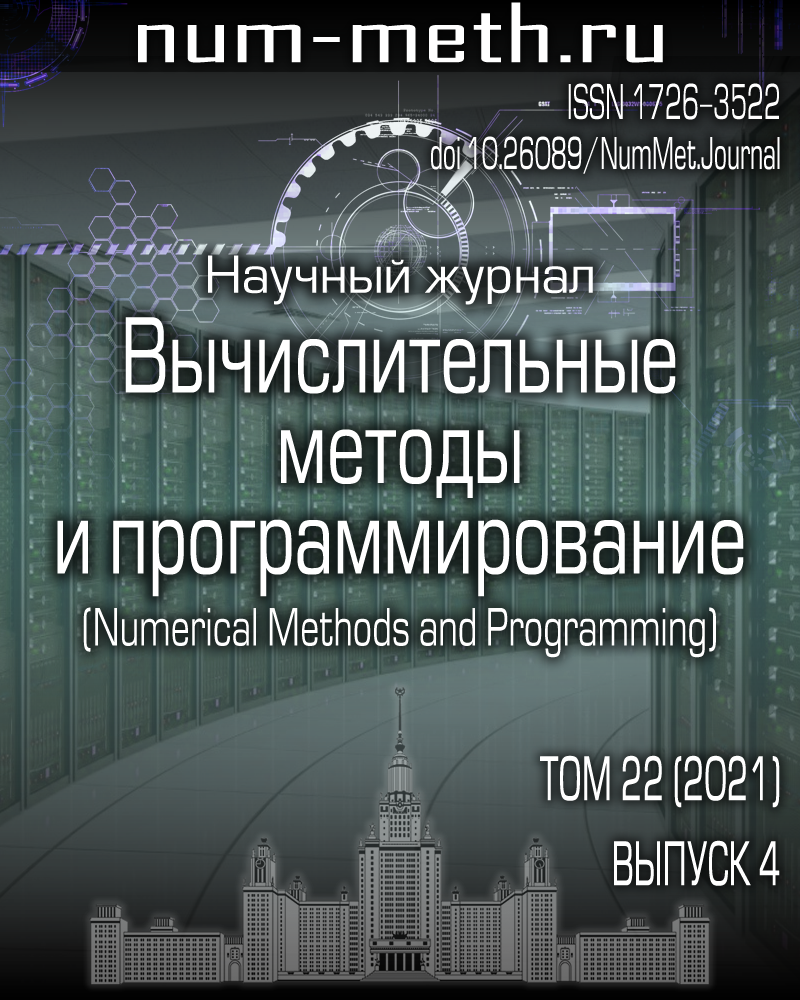DOI: https://doi.org/10.26089/NumMet.v22r421
Реализация и производительность алгоритмов волновой томографии на вычислительных платформах SIMD CPU и GPU
Ключевые слова:
Аннотация
В данной статье рассматривается реализация алгоритмов волновой томографии на современных вычислительных платформах SIMD CPU и GPU. Область волновой томографии, которая в настоящее время находится в стадии разработки, требует мощных вычислительных ресурсов. Основные области применения волновой томографии - это медицинская визуализация, неразрушающий контроль, сейсмические исследования. Практические приложения зависят от вычислительного оборудования. Восстановление томографического изображения методом волновой томографии включает решение коэффициентов обратной задачи для волнового уравнения. Такие проблемы могут быть решены с помощью итерационных градиентных методов, основанных на многократном численном моделировании процесса распространения волн. В этом исследовании для моделирования волн используется метод конечных разностей во временной области (FDTD). В статье обсуждается программная реализация алгоритмов и сравнивается производительность различных вычислительных устройств: многоядерных процессоров Intel и ARM, графических процессоров NVidia.
Опубликован
Выпуск
Раздел
Библиографические ссылки
- M. V. Klibanov and A. A. Timonov, Carleman Estimates for CoefficientInverse Problems and Numerical Applications} (De Gruyter, Berlin, 2004), doi{10.1515/9783110915549.
- M. Birk, R. Dapp, N. V. Ruiter, and J. Becker, “GPU-based Iterative Transmission Reconstruction in 3D Ultrasound Computer Tomography,” J. Parallel Distrib. Comput. 74 (1), 1730-1743 (2014). doi{10.1016/j.jpdc.2013.09.007}.
- J. Wiskin, D. Borup, M. Andre, et al., “Three-Dimensional Nonlinear Inverse Scattering: Quantitative Transmission Algorithms, Refraction Corrected Reflection, Scanner Design, and Clinical Results,” J. Acoust. Soc. Am. 133 (2013). doi{10.1121/1.4805138}.
- V. A. Burov, D. I. Zotov, and O. D. Rumyantseva, “Reconstruction of Spatial Distributions of Sound Velocity and Absorption in Soft Biological Tissues Using Model Ultrasonic Tomographic Data,” Acoust. Phys. 60 (4), 479-491 (2014). doi{10.1134/S1063771014040022}.
- S. Romanov, “Simulations in Problems of Ultrasonic TomographicTesting of Flat Objects on a Supercomputer,” inCommunications in Computer and Information Science}(Springer, Cham, 2020), Vol. 1331, pp. 320-331. doi{10.1007/978-3-030-64616-5_28.
- A. V. Goncharsky and S. Y. Seryozhnikov, “Supercomputer Technology for Ultrasound Tomographic Image Reconstruction: Mathematical Methods and Experimental Results,” in Communications in Computer and Information Science}(Springer, Cham, 2019), Vol. 965, pp. 401-413. doi{10.1007/978-3-030-05807-4_34.
- A. V. Goncharsky and S. Y. Seryozhnikov, “Three-Dimensional Ultrasound Tomography: Mathematical Methods and Experimental Results,” in Communications in Computer and Information Science}(Springer, Cham, 2019), Vol. 1129, pp. 463-474.doi{10.1007/978-3-030-36592-9_38.
- A. V. Goncharsky, V. A. Kubyshkin, S. Y. Romanov, and S. Y. Seryozhnikov, “Inverse Problems of Experimental Data Interpretation in3D Ultrasound Tomography,” Vychisl. Metody Programm. 20 (3), 254-269 (2019).doi{10.26089/NumMet.v20r323}.
- A. Bakushinsky and A. Goncharsky, Ill-Posed Problems: Theory and Applications (Kluwer Academic Publishers, Dordrecht, 1994).
- A. N. Tikhonov, A. V. Goncharsky, V. V. Stepanov, and A. G. Yagola, Numerical Methods for the Solution of Ill-Posed Problems (Kluwer Academic Publishers, Dordrecht, 1995).
- A. V. Goncharsky and S. Y. Romanov, “Iterative Methods for Solving Coefficient Inverse Problems of Wave Tomography in Models with Attenuation,” Inverse Probl. 33(2), (2017). doi{10.1088/1361-6420/33/2/025003}.
- F. Natterer, “Sonic Imaging,” in Handbook of Mathematical Methods in Imaging}(Springer, New York, 2014), pp. 1253-1278.doi{10.1007/978-1-4939-0790-8_37.
- A. Bakushinsky and A. Goncharsky, Iterative Methods for Solving Ill-Posed Problems (Nauka, Moscow, 1989) [in Russian].
- R. K. Saha and S. K. Sharma, “Validity of a Modified Born Approximation for a Pulsed Plane Wave in Acoustic Scattering Problems,” Phys. Med. Biol. 50 (12) (2005).doi{10.1088/0031-9155/50/12/007}.
- D. Yokoyama, B. Schulze, F. Borges, and G. Mc Evoy, “The survey on ARM processors for HPC,” J. Supercomput. 75, 7003-7036 (2019).doi{10.1007/s11227-019-02911-9}.
- V. V. Voevodin, A. S. Antonov, D. A Nikitenko, et al., “SupercomputerLomonosov-2: Large Scale, Deep Monitoring and Fine Analytics for the User Community,” Supercomput. Front. Innov. 6 (2), 4-11 (2019).doi{10.14529/jsfi190201}.
- B. Engquist and A. Majda, “Absorbing Boundary Conditions for the Numerical Simulation of Waves,” Math. Comput. 31, 629-651 (1977).doi{10.1090/S0025-5718-1977-0436612-4}.
- B. Hamilton and S. Bilbao, “Fourth-Order and Optimised Finite Difference Schemes for the 2-D Wave Equation,” in Proc. 16th Int. Conf. on Digital Audio Effects, Maynooth, Ireland, September 2-6, 2013 ,
https://www.pure.ed.ac.uk/ws/portalfiles/portal/11221940/dafx2013_submission_64.pdf. - WaveTomography software.
http://inverseproblems.ru/WaveTomography . Cited December 10, 2021.
Лицензия
Copyright (c) 2021 А.В. Гончарский, С.Ю. Романов, С.Ю. Серёжников

Это произведение доступно по лицензии Creative Commons «Attribution» («Атрибуция») 4.0 Всемирная.


